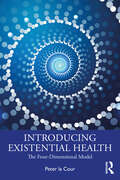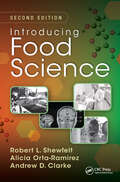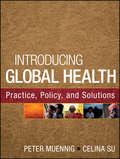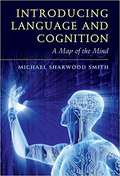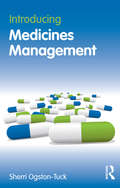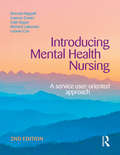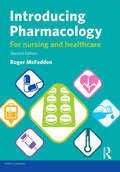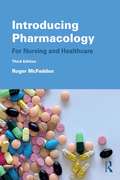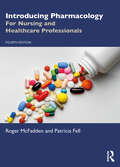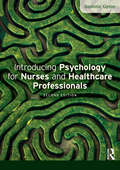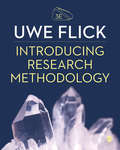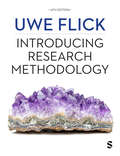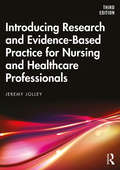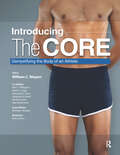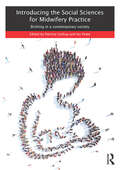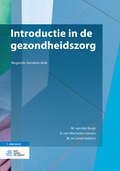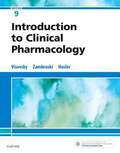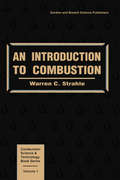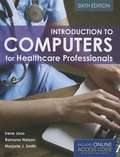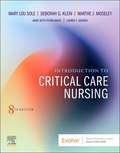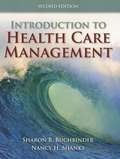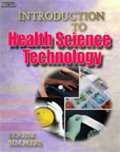- Table View
- List View
Introducing Existential Health: The Four-Dimensional Model
by Peter la CourIntroducing Existential Health unfolds this evolving concept and places it in the context of common understandings of health. It presents existential health as a vital dimension in understanding human well-being, complementing the traditional biopsychosocial model. It critiques reductionist and mechanistic views of health and showcases a new four- dimensional model in healthcare practice and design that integrates biological, psychological, social, and existential dimensions. Presented as a valid alternative to the biopsychosocial model, it provides modern system thinking and a holistic understanding centred around meaning and the first- person perspective to give a voice to intersectional discourses and encourage equality in health.The book traces the historical evolution of health understandings, highlighting the gaps in addressing subjective and existential perspectives. It examines existential health through various lenses, including meaning- making, subjective experiences, and empirical correlations with other dimensions of health. Practical applications are discussed, emphasising the role of existential health in prevention, chronic disease management, and end-of-life care. The book also advocates for educational reforms to include training in existential health approaches and holistic care. By enriching the language and frameworks for existential health, this book aims to inspire a cultural shift in healthcare towards a more integrative and person-centred paradigm.The book is intended for all health professionals interested in the quality of healthcare in modern society and for health education. The models presented in the book are of a heuristic nature, suitable for reflection, discussion, and teaching about health. It is also valuable reading for researchers in academic health professions and those in the development of health politics, searching for arguments and stepping stones for a more holistic health perspective.
Introducing Food Science
by Robert L. Shewfelt Andrew D. Clarke Alicia Orta-RamirezWritten as an introductory food science textbook that excites students and fosters learning, the first edition of Introducing Food Science broke new ground. With an easy-to-read format and innovative sections such as Looking Back, Remember This!, and Looking Ahead, it quickly became popular with students and professors alike. This newly r
Introducing Global Health: Practice, Policy, and Solutions
by Peter Muennig Celina SuIntroducing Global Health: Practice, Policy, and Solutions is a contemporary overview of the major issues in global public health. The book explores how population health might be maximized with the right blend of health system, education, antipoverty, infectious disease, urban development, governance, and incentive-based policies. It covers topics critical for understanding the state of the world today, including wars for natural resources, the missing women phenomenon, and whether global aid really works. The book's case studies focus on developing economies, mixed economies, and new emerging superpowers. Thematic chapters are interwoven with running motifs, such as the health risks and benefits associated with different totalitarian, capitalist, and market socialist economies. Moving beyond statistics, the book represents a major innovation in the teaching of global health by presenting technical concepts including the incidence and prevalence of disease within the context of more accessible topics such as global poverty. This helps students contextualize otherwise challenging but critical concepts, such as the burden of infectious disease. By encouraging reflection, focusing on what works, and using activities and exercises, Introducing Global Health both teaches fundamentals of global public health and cultivates a policy perspective that is appealing and compelling for today's students.
Introducing Language and Cognition
by Smith Michael SharwoodIn this accessible introduction, Mike Sharwood Smith provides a working model or 'map' of the mind, with language as its centrepiece. Drawing on cutting-edge research across linguistics, psychology and neuroscience, it allows students to quickly grasp how each separate aspect of the mind's operations can be related. This 'big picture' view includes the way the mind makes, stores and loses memories of all kinds as well how its various 'expert systems' combine and collaborate to solve, typically beyond our conscious awareness, the myriad of tasks we are faced with every minute and millisecond of our existence. The book also focuses on language, that is, the mind of monolingual, bilingual and multilingual speakers. It will be of interest to all students wishing to learn more about the complex relationship between language - one of the most important ways in which we define ourselves as human - and the mind.
Introducing Medicines Management
by Sherri Ogston-TuckMedicine administration is a fundamental aspect of the nursing role, carrying with it great risk, and requiring a high level of skill and background knowledge. This student friendly text will take you through the basic concepts of medicines management, to the essential skills needed in practice.Introducing Medicines Management provides an awareness of the inter-relationship between the patient, the medicine and the prescription as a fundamental systems approach, and will help you to understand how this is related to medicines management.
Introducing Mental Health Nursing: A service user-oriented approach
by Brenda Happell Leanne Cowin Richard Lakeman Leonie Cox Cath RoperIntroducing Mental Health Nursing offers a systematic overview of both the science and the art of caring for people experiencing mental health problems. It addresses the attitudes, knowledge and skills required to provide care for service users across all health-care settings, from specialist mental health services to general hospitals and community care.The authors place the service user at the centre of all aspects of mental health care and emphasise the importance of the therapeutic relationship as the cornerstone of good mental health nursing practice. Emphasis is placed on the role of the nurse as an intrinsic member of the mental health team, and nurses are encouraged to think critically about the perspectives that they bring to their practice.The second edition has been fully revised and updated, with increased focus on Indigenous social and emotional well-being, as well as two new chapters on Recovery and Cultural Safety. A must-have book for undergraduate nursing students, new graduates and professionals changing specialties or simply wishing to refresh their mental health nursing knowledge.'This is a brave and dignified text - beautifully written and conceived and given the current texts available - a must for any serious undergraduate nursing program in an Australian university.' - David Buchanan, De Montfort University, Leicester, United Kingdom'I recommend this text to all students of nursing, whether you intend to pursue a career in this speciality or if you simply desire to provide the best care possible in any field of practice.' - Associate Professor Stephen Elsom RN PhD, Director, Centre for Psychiatric Nursing, The University of Melbourne
Introducing Pharmacology: For Nursing and Healthcare
by Roger McFaddenThis new edition of Introducing Pharmacology remains an accessible and relevant introduction for nursing and healthcare students who are new to pharmacology, as well anyone looking to refresh their knowledge of the subject. Focused and engaging, the text balances accessibility with depth. Coverage of anatomy and physiology as well as pathophysiology helps to relate the subject to practical realities and makes this text stand out. It includes: Concise explanations of how drugs work in the human body. Explains the underlying physiology and pathophysiology necessary for an understanding of the action of drugs. All of the common drug groups that practitioners are likely to encounter in clinical practice. New to this edition: Additional chapter on cancer and anti-cancer drugs. New sections, including general anaesthetics, hay-fever and prescribing for special groups such as children, pregnant women and the elderly. Updated to include the latest UK prescribing guidelines. New case-studies, relating pharmacological theory to clinical practice. Inclusion of a new glossary of key terms and definitions.
Introducing Pharmacology: For Nursing and Healthcare
by Roger McFaddenThis third edition of Introducing Pharmacology provides an accessible and engaging introduction to the subject of pharmacology for nursing and healthcare students – and anyone needing to refresh their knowledge of this important area. The third edition recognises that many nursing and healthcare courses are now requiring students to engage with the subject of pharmacology at a higher level. Accordingly, this edition has been reinforced with more advanced pharmacology that will help these students, but without losing the clarity and accessibility of earlier editions. This popular text includes: • Clear explanations of how drugs work in the human body • The underlying physiology and pathophysiology necessary for an understanding of the action of drugs • Coverage of the common drug groups that nurses and other healthcare professionals are likely to encounter in practice • Case-studies, relating pharmacological theory to clinical practice • An extensive glossary of key terms and definitions New to this edition: A new ‘beyond the basics’ feature, providing a deeper explanation of the mechanism of action of key drugs, supporting students studying at a more advanced level A new section covering drugs for the treatment of nausea and labyrinthine disorders An expanded chapter on drug metabolism and pharmacokinetics Enhanced and more detailed illustrations Updated content that reflects latest guidelines and recently licensed drugs
Introducing Pharmacology: For Nursing and Healthcare Professionals
by Roger McFadden Patricia FellThis fourth edition of Introducing Pharmacology provides an accessible and engaging introduction to the subject of pharmacology for nursing and healthcare students – in fact any healthcare professional needing to refresh their knowledge of this important area. The fourth edition has been fully updated to include recently introduced drugs and a completely new chapter that takes the reader through the process of drug development and the clinical trials that are required before a drug is licensed for prescribing to patients. Acknowledging the COVID pandemic of 2020/21, a review of the vaccines and drugs used against coronavirus (SARS-CoV-2) is included in this edition. This popular text includes: Clear explanations of how drugs work in the human body The underlying physiology and pathophysiology necessary for an understanding of the action of drugs Coverage of the common drug groups that nurses and other healthcare professionals are likely to encounter in practice Case-studies relating pharmacological theory to clinical practice ‘Beyond the basics’. A feature providing an in-depth explanation of the mechanism of action of key drugs. Useful for students studying at a more advanced level New to this edition: A new chapter explaining how drugs are developed and undergo testing in clinical trials. This chapter also includes a section on the critical analysis of clinical trials and a brief explanation of the statistics used to present trial data An expanded chapter on pharmacokinetics, including the effect of renal and hepatic insufficiency on drug metabolism, and the new science of pharmacogenomics – the matching of drugs to patients, based on their individual genetics A new section on common skin complaints, psoriasis, eczema and the drugs used to treat them An expanded section on post-menopausal problems and the drugs used to alleviate symptoms Updated content that reflects the latest guidelines and recently licensed drugs This textbook is an essential companion for nursing, midwifery students and other healthcare professions, as well as those on post-registration courses, studying to become independent prescribers.
Introducing Psychology for Nurses and Healthcare Professionals
by Dominic UptonWhat makes someone feel healthy? Why do some people respond differently under stress to others? Why don't people always follow nursing advice?This second edition of Introducing Psychology for Nurses and Healthcare Professionalsprovides an accessible but thorough introduction to the key psychological theories and concepts which underpin nursing and healthcare, and clearly demonstrates how they can be applied in clinical practice. Using a research-led approach, each chapter guides you through important theories and topics in health psychology, such as lifespan and development, communication, and social processes, and helps you use your understanding to deliver better patient care.
Introducing Research Methodology: Thinking Your Way Through Your Research Project
by Uwe FlickOffering an encyclopedic introduction to research, this book shows you how to think about every stage of their project and equips you with the tools you need to understand different research processes. Packed with examples showing the diversity of research, this third edition provides hands-on guidance to help: Develop key academic skills like critical thinking, effective writing and building an argument Confidently interpret findings, assess arguments and understand the wider impact of their research Understand the challenges and opportunities involved in working with new types of data like social media and online data Supported by a dynamic new website with downloadable templates, case studies, dos and don’ts videos and more, this practical book prepares you for not just getting to grips with methodological concepts, but being ready to apply them.
Introducing Research Methodology: Thinking Your Way Through Your Research Project
by Uwe FlickOffering an encyclopedic introduction to research, this book shows you how to think about every stage of their project and equips you with the tools you need to understand different research processes. Packed with examples showing the diversity of research, this third edition provides hands-on guidance to help: Develop key academic skills like critical thinking, effective writing and building an argument Confidently interpret findings, assess arguments and understand the wider impact of their research Understand the challenges and opportunities involved in working with new types of data like social media and online data Supported by a dynamic new website with downloadable templates, case studies, dos and don’ts videos and more, this practical book prepares you for not just getting to grips with methodological concepts, but being ready to apply them.
Introducing Research Methodology: Thinking Your Way Through Your Research Project
by Uwe FlickNew to research? This book helps you understand, think about and interpret each stage of the research process before you dive in. The holistic coverage helps you ′think through′ each step, from formulating questions and selecting methods to collecting data and analyzing results. With new content on the ethics of digital research, online interviews and data protection, you will also find: 10 new Student Research Spotlights that demonstrate how you can foster a reflexive mindset; A strong emphasis on social justice, including principles for culturally-responsive research and methodologies that challenge colonial perspectives; 34 case studies of real-world research that apply theory to global contexts, from Portugal to Germany to Canada. This new edition is essential for any undergraduate or postgraduate student looking to conduct social research with confidence and capability.
Introducing Research Methodology: Thinking Your Way Through Your Research Project
by Uwe FlickNew to research? This book helps you understand, think about and interpret each stage of the research process before you dive in. The holistic coverage helps you ′think through′ each step, from formulating questions and selecting methods to collecting data and analyzing results. With new content on the ethics of digital research, online interviews and data protection, you will also find: 10 new Student Research Spotlights that demonstrate how you can foster a reflexive mindset; A strong emphasis on social justice, including principles for culturally-responsive research and methodologies that challenge colonial perspectives; 34 case studies of real-world research that apply theory to global contexts, from Portugal to Germany to Canada. This new edition is essential for any undergraduate or postgraduate student looking to conduct social research with confidence and capability.
Introducing Research and Evidence-Based Practice for Nursing and Healthcare Professionals
by Jeremy JolleyResearch can seem difficult to get to grips with. However, at the heart of this book is the view that research is essentially a simple activity, the principles of which can be readily understood by students new to the subject. Each chapter guides the reader to uncover the 'mysteries' of research, exposing each aspect in turn, while demonstrating how research in healthcare is a practical activity, orientated directly to patient care. Fully updated to refer to the latest sources and studies, this book now includes: Two new chapters on qualitative research, clearly explaining what it is and how to do it A comprehensive glossary of qualitative and quantitative terms to demystify tricky terminology An appendix of statistical tests, explaining the procedures for each Many new examples from practice, applying the theory to a wide range of scenarios from across the healthcare professions This book is designed for all students of nursing and allied health professions studying research for the first time. Research is illustrated through examples of activities familiar to students from their daily lives, helping to build confidence in undertaking research and evidence-based practice.
Introducing Research and Evidence-Based Practice for Nursing and Healthcare Professionals
by Jeremy JolleyResearch can seem difficult to get to grips with. However, at the heart of this new edition is the view that research is essentially a simple activity, the principles of which can be readily understood by students new to the subject. Each chapter guides the reader to uncover the ‘mysteries’ of research, exposing each aspect in turn, while demonstrating how research in healthcare is a practical activity, orientated directly to patient care. Fully updated to refer to the latest sources and studies, the third edition includes: a new chapter on systematic literature views; a new chapter on research ethics; a completely revised chapter on evidence-based practice which now focuses more tightly on the implementation of research and other forms of evidence. This book is designed for all students of nursing and allied health professions at any level but who find themselves studying research for the first time. Research is illustrated through examples of activities familiar to students from their daily lives, which help build confidence in undertaking research and evidence-based practice.
Introducing the Core: Demystifying the Body of an Athlete
by Michael J. Bradley Rob Gordon Marc J. Philippon Adam C. Zoga Alexander E. Poor Johannes B. Roedl Jim McCrossin Alex McKechnieThere is no more important area of the body for an athlete than the core, the region of our body from our chest to our knees. The core is our engine, our hub of activity. Strength there makes life easier for shoulders and knees. It produces speed and explosiveness. Endurance and grit.The core is so important. So why has it remained such a medical mystery?This book will explain that.Introducing the Core: Demystifying the Body of an Athlete traces the arc of the journey from injury to restoration of power to the return to normal life.Dr. William Meyers is the nation’s foremost authority on core health. Along with over 40 world-renowned expert contributors, Dr. Meyers explains how the core functions through stories from his work in locker rooms, the operating room, and the playing fields of elite athletes, giving readers a thorough understanding of the core’s widespread influence on athleticism and the human anatomy.The book: Dissects the events that led Dr. Meyers and his team of experts to their new appreciation of this anatomy Brings multiple world-renowned arthroscopists into the overall core picture, providing their perspectives on how the core works, with the pubic bone as “the sun” of the body’s universe Offers insight into the many causes of pelvic pain, demonstrating why the term “sports hernia,” should be banished forever Emphasizes the fact that a wide spectrum of professionals treat the core -- from traditional surgeons to alternative therapists Brings it all together and proposes a new future, and perhaps a new medical specialty, that is the core “Strength, power, and endurance all flow from the core. This book, and the work Bill Meyers has done in the field, will bring good core health to the forefront and help everyone—elite athletes and others.”—Michael William Krzyzewski“Even in baseball, injury patterns in the shoulder and elbow are related to core imbalance. This book has been needed for a long time… Bill has helped the idea of core strength become more popular, and this book could be what is needed to get it more attention.”—James Rheuben Andrews, MD“To understand the core, you must put on new eyes.” —Marshawn Lynch
Introducing the Social Sciences for Midwifery Practice: Birthing in a Contemporary Society
by Ian Peate Patricia LindsayIntroducing the Social Sciences for Midwifery Practice makes clear the links between social, anthropological and psychological concepts, midwifery practice and women’s experience of birth. Demonstrating how empathising with women and understanding the context in which they live can affect childbirth outcomes and experiences, this evidence-based text emphasises the importance of compassionate and humane care in midwifery practice. Exploring midwifery as an art, as well as a science, the authors collected here make the case for midwives as professionals working ‘with women’ rather than as birth technicians, taking a purely competency-based approach to practice. The book incorporates a range of pedagogical features to enhance student learning, including overall chapter aims and learning outcomes, ‘recommendations for practice’, ‘learning triggers’ to encourage the reader to delve deeper and reflect on practice, ‘application to practice’ case studies which ensure that the theory is related to contemporary practice, and a glossary of terms. The chapters cover perspectives on birth from sociology; psychology; anthropology; law; social policy and politics. Other chapters address important issues such as disability, politics and sexuality. Outlining relevant theory from the social sciences and clearly applying it to practice, this text is an essential read for all student midwives, registered midwives and doulas. ?
Introductie in de gezondheidszorg
by M. van der Burgt E. van Mechelen-Gevers M. te Lintel HekkertIntroductie in de gezondheidszorgIntroductie in de gezondheidszorg biedt een helder overzicht over de organisatie en het functioneren van de gezondheidszorg in Nederland. In deze herziene druk wordt het zorgstelsel helder uitgelegd. De contouren van de meest recente veranderingen worden geschetst, zoals de invoering van de Wet langdurige zorg als opvolger van de AWBZ en de decentralisatie van de Jeugdzorg en Participatiewet. In de loop van de komende jaren zal blijken hoe deze wetten zullen uitpakken.Ketenzorg, vraagsturing en marktwerking in de zorg komen aan bod. Daarnaast worden verzekerde zorg, bekostiging, dbc’s en kostenbeheersing besproken. Ook wordt verhelderd in welke opzichten de zorgmarkt afwijkt van de ‘gewone’ markt. Daarmee worden in begrijpelijke taal vragen beantwoord, zoals: Wat maakt het uit of zorg via de Zorgverzekeringswet, de Wet langdurige zorg of Wet maatschappelijke opvang is geregeld? En: Waarom zit preventie niet in de basiszorg?Kortom, een boek dat het ingewikkelde veld van de gezondheidszorg voor studenten en beginnende professionals inzichtelijk maakt.Op de bijbehorende website staan toetsvragen en links naar sites en documenten.Door de overzichtelijke tabellen, figuren en trefwoordenlijst is Introductie in de gezondheidszorg onmisbaar als basisboek voor studenten in het hoger beroepsonderwijs die in de gezondheidszorg gaan werken. Daarnaast is het een praktische en toegankelijke introductie voor iedere geïnteresseerde en een handig naslagwerk voor mensen die al in de gezondheidszorg werkzaam zijn.Marieke van der Burgt is arts en voorlichtingsdeskundige in de gezondheidszorg en docent aan het Rijn IJssel in Arnhem. Els van Mechelen-Gevers is werkzaam als publicist op het gebied van gezondheidszorg en patiëntenvoorlichting.Marieke van der Burgt en Els van Mechelen-Gevers zijn auteur van onder andere ‘Preventie en gezondheidsbevordering door paramedici’ en ‘Patiëntenvoorlichting door verpleegkundigen. Stappen naar zelfmanagement’.Martin te Lintel Hekkert is verpleegkundige, verplegingswetenschapper en docent verpleegkunde aan de Christelijke Hogeschool te Ede. Hij is onder meer auteur van de ‘Richtlijn zelfmanagement van patiënten met COPD in de huisartspraktijk’.
Introduction To Clinical Pharmacology
by Constance Visovsky Cheryl Zambroski Shirley HoslerEmphasizing safe and effective drug administration, Introduction to Clinical Pharmacology, 9th Edition helps you understand the principles of pharmacology to avoid making medication errors. It promotes safety by showing how drugs and drug classes work, so you can understand why drugs are given, as well as the adverse effects and drug interactions that may occur. This new edition includes Lifespan Considerations which explain important alerts you need to be aware of when administering drugs to pediatric and geriatric patients. The 9th edition also includes a nursing process section which outlines each drug class along with the nurse's role during administration. Written by a new team of nationally known nursing educators, this text provides just the right scope of nursing pharmacology content for most LPN/LVN programs. <P><P> Safety Alert boxes highlight important nursing considerations for safe medication administration and monitoring. <P><P>Lifespan Considerations boxes for Children and Older Adults draw attention to information that would be especially important when giving a specific drug to patients of those age groups. <P><P>Get Ready for the NCLEX® Examination! section includes Key Points, Review Questions, and Case Studies with Critical Thinking Questions to prepare you for pharmacology questions on the NCLEX-PN Exam. <P><P>Video clips on medication administration procedures provide you with a visual reference for safe medication administration. <P><P>Ideal scope of content and readability for LPN/LVN programs includes basic, need-to-know pharmacology content. <P><P>A focus on understanding drug classes rather than memorizing individual drugs helps you understand the actions and uses of drug classes and provides a framework for safe, effective practice as new drugs are introduced to the market. <P><P>Key content is highlighted, as in all of Elsevier's LPN Threads textbooks, with features such as Top Tips for Safety, Memory Joggers, and Lifespan Considerations boxes. <P><P>Key terms with phonetic pronunciations and text page references help improve terminology and language skills before you enter clinical practice. <br>NEW! Chapter on Eye and Ear Medications focuses on important glaucoma treatments. NEW! Dosage ranges added to drug tables reinforce safe medication administration NEW! Top tips for safety and clinical care provide you with advice from practicing nurses in applicable situations. NEW! Expanded content on cultural considerations help you think about ethnic differences that may relate to each drug class. NEW! Drug and IV calculation questions test your knowledge of dosages and calculations.
Introduction To Combustion (Combustion Science And Technology Book Ser. #Vol. 1)
by Warren C. StrahleThis book presents basic information about combustion, mostly in the form of examples. It is a textbook for a one-semester or one-quarter course for juniors or seniors in mechanical, aerospace, chemical, or civil engineering.
Introduction To Computers For Healthcare Professionals
by Ramona Nelson Irene Joos Marjorie J. SmithThe only computer and information literacy book designed specifically for students in health care disciplines, Introduction to Computers for Healthcare Professionals, Fourth Edition explains hardware, popular software programs, operating systems, research applications, and computer-assisted communication, including sections on information access, evaluation and use, and the Internet. Built on the Computers in Small Bytes Foundation, the revised Fourth Edition continues to present this information with great detail and clarity, featuring the most recent MS Office programs, and focusing on the security of systems and data.
Introduction To Critical Care Nursing
by Mary Lou Sole Deborah Goldenberg Klein Marthe J. MoseleyStart here to master the concepts, technology, and procedures of critical care nursing! Introduction to Critical Care Nursing, 8th Edition prepares you to provide safe, effective, patient-centered care in a variety of high-acuity, progressive, and critical care settings. Evidence-based coverage includes realistic case studies and incorporates the latest advances in critical care. Disorders are conveniently organized by body system or special situation, and nursing management chapters include quick-reference nursing care plans. This clear, concise textbook will help you develop the knowledge and clinical reasoning skills needed for success in today's highly complex critical care environments.
Introduction To Health Care Management
by Sharon B. Buchbinder Nancy H. ShanksIntroduction to Health Care Management is a concise, reader-friendly, introductory healthcare management book that covers a wide variety of healthcare settings, from hospitals to nursing homes and clinics. Filled with examples to engage the reader's imagination, the important issues in healthcare management, such as ethics, cost management, strategic planning and marketing, information technology, and human resources, are all thoroughly covered. Guidelines and rubrics along with numerous case studies make this text both student-friendly and teacher friendly. It is the perfect resource for students of healthcare management, nursing, allied health, business administration, pharmacy, occupational therapy, public administration, and public health. "Drs. Buchbinder and Shanks have done a masterful job in selecting topics and authors and putting them together in a meaningful and coherent manner. Each chapter of the book is designed to give the student the core content that must become part of the repertoire of each and every healthcare manager, whether entry level or senior executive. Each of the chapters and accompanying cases serve to bring to life what it means to be a truly competent healthcare manager.
Introduction To Health Science Technology
by Louise SimmersIntroduction to Health Science Technology covers the core information needed to pursue a career in health care from an introduction of the health care industry and the basics of a health care system to overview of health care careers and legal and ethical responsibilities of health care workers to medical terminology and basic anatomy and physiology.
